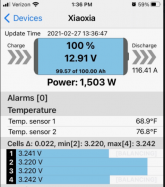Not my cells. A friend was top balancing, and got in a rush. Turned the voltage up on a batch of cells, and walked away for a quick drink. Forgot about the cells until the next morning.
The cells were over 5V the next morning.

I had him pull the cells down to 3.6V right away.
They went pretty flat once put in a fixture. Still a noticeably bulged though.

I had him do a test discharge/charge cycle outside just in case. I will report back with the capacity test results. I am curious what kind of degradation the cells experienced. Anyone wanna take bets?


The cells were over 5V the next morning.

I had him pull the cells down to 3.6V right away.
They went pretty flat once put in a fixture. Still a noticeably bulged though.

I had him do a test discharge/charge cycle outside just in case. I will report back with the capacity test results. I am curious what kind of degradation the cells experienced. Anyone wanna take bets?





